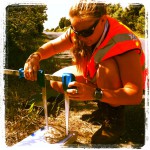What did you do this summer?
Experience gained; many terrapins saved!
by Kristin Ryerson, CWF Terrapin Project Intern

“What did you do this summer?” was a question I was frequently asked by family, friends and classmates when I recently returned to college this fall. Well, where to begin! Ben Wurst, CWF’s Habitat Program Manager, set a goal this summer to lower the number of road killed Northern Diamondback Terrapins on Great Bay Boulevard in Tuckerton, NJ. In previous studies, 50 terrapins could be killed in one nesting season—the main cause? People. Careless drivers who are either speeding or simply oblivious to the many yellow signs warning them of crossing nesting terrapins and the fact that they are in the middle of an extremely vital wildlife refuge. So, this summer, I had the privilege of being the Great Bay Terrapin Project’s Intern, and my job was to help save nesting terrapins crossing the road and to take valuable data on those I saw. Ben gave me some equipment and the knowledge I would need when working on the road. Through road patrols, educating the public, maintaining the previously installed barrier fencing, painting road signs and data collection, I learned more than I had imagined and had an amazing experience.

There were many volunteers that drove or walked for hours throughout May, June and July, the peak months for nesting. They recorded the date, time, number of terrapins seen, whether they were alive or dead and recorded the location. Together, the volunteers, Ben and I saw a total of 1064 terrapins this summer, only 36 of which were dead, which is a huge improvement! I compiled all of these sightings and broke them down by week, and Ben will be able to determine how the weather, temperature and tides were factors in when nesting was the busiest throughout the season.
In addition, I was able to record the weight, age, carapace length, width and height, plastron length, quantity of marginal, coastal and vertebral scutes and whether the nuchal was split or not. I also recorded other data such as the temperature, weather condition and time of day. I made graphs for each type of data and figured out the average and minimum and maximum. All of this data will be interpreted by Ben in the future and will be very helpful to him and others.
Throughout the summer, a few volunteers, Ben and I encountered females that had been run over, yet their eggs were still salvageable. When this was the case, we would almost dissect the female, and take the eggs we could and transfer them to a hatchery, either at the Tuckerton Seaport or the LBI Arts Foundation. Here I would dig a hole in the sand and deposit the eggs the same way they were laying inside the female, and hopefully they will hatch out and survive. One instance, early in the summer, a mower from Little Egg Harbor Township ran over a female, and it was horrible to see this poor terrapin still alive, yet her insides were pouring out of her shell, we were able to salvage seven of her eggs and hopefully her young will have a better chance then she.

Another incidence was one morning my father was driving to work over the causeway to Manahawkin and the car in front of him clipped the side of a terrapin, my father pulled over, put it in his truck and drove it over to me. Ben and I decided it might get an infection if not treated, so I drove her up to The Lighthouse Center for Environmental Resource Education in Waretown. There, a grad student from Drexel was able to epoxy her shell and check on her health for about a week. I picked her up and was able to release her back into the bay right by the Shack going onto LBI.

Another interesting situation this summer is when I was scanning the terrapins for PIT tags, one terrapin showed up with a number. I emailed Ben and later Stephanie Egger from CWF, and turns out she had tagged this terrapin seven years ago. It was pretty amazing to see where she had traveled in those seven years and also that she was still alive!
This summer, in addition to working with the terrapins, Ben took me out a few times to help band and take other data on the Peregrine Falcons and Ospreys in our areas, it was truly amazing to be in their presence and that was icing on the cake! All in all, I came away with many great experiences and am so honored to have had the privilege of working with Ben and learning all I did!
Kristin is the first intern that I’ve ever hired to help with my field work. I can not thank her enough. She was very self reliant and worked as a volunteer while working full time at Kelly’s in Barnegat Light. Kristin managed to work in one of the most hostile environments along our coast! Great Bay Blvd is home to the trifecta of biting insects (mosquitoes, no-see-ums, deer flies, dog ticks, and huge onslaughts of greenheads) and she did not complain one bit about working out there! Myself and the many terrapins that inhabit Great Bay are grateful for your hard work this summer! -Ben
Discover more from Conserve Wildlife Foundation of NJ
Subscribe to get the latest posts sent to your email.